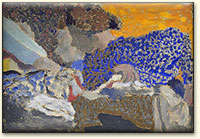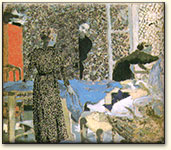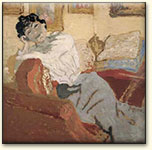Édouard Vuillard
Édouard Vuillard (1868-1940) is best remembered for his intimate Parisian interiors of the 1890’s and his paintings of the Parisian Belle Epoque (1880-1914), a period of intellectual and artistic refinement. Vuillard was a member of the Nabi group, formed in 1889 with the artists Paul Sérusier (1864-1927), Maurice Denis (1870-1943) and Pierre Bonnard (1867-1947). The group combines painting with decorative art and is inspired by literary symbolism, exoticism and orientalism. According to the Nabi artists, every emotion has “a plastic, decorative equivalent” that corresponds our sense of beauty — an idea that contrasted the dominant ideas of positivism and naturalism. The non-naturalistic Nabi colors later become a source of inspiration for many artists such as the Fauve painters, including Henri Matisse.
In the early 1890’s, Vuillard’s work develops an interest in a decorative style that often appears so patterned that our eye struggles to make sense of the depicted subjects. Vuillard lived with his mother, a seamstress who worked for corset and dressmaking business, and was influenced by his mother’s non-representational fabric patterns. Two Seamstresses in the Workroom (1893) represents the profiles of two women who worked for Vuillard’s mother. Vuillard had depicted them in the varying tones of contrasting blue, yellow and brown in a manner that evokes abstract art.
Vuillard’s art challenges and plays with our peripheral vision. Interior at L’Etang-la Ville (1893) represents a pattern of black, brown, beige and blue dots that are repeated in the woman’s dress, the wallpaper and the window curtain. At right, a combination of white and beige dots suggests an area of light coming from a window that is left open, bringing in a flow of air that moves the tablecloth. Although the repeated dots disallow the spectator’s illusion of depth, the dotted blurriness matches our peripheral vision and suggests an illusion of passing moment. Vuillard’s painting seems to float, even having an element of movement. It is as if the man had just opened the door, the woman at right had just got up from her chair to greet him, and the woman at left had just opened the window. As no area is painted on a precise manner, our eye struggles to find a point of focus. The eye takes momentary refuge on the non-dotted black clothes of the man and the woman at right and then moves on to the blue tablecloth and the red wardrobe. However, none of these elements satisfy our fovea vision, the center of gaze, as they lack a detailed visual acuity. Thus, Vuillard’s technique of dots appears less specific than, for instance, Paul Signac’s (1863-1935) or Georges Seurat’s (1859-1891) pointillist technique.
Vuillard’s Madame Hessel on the Sofa (c. 1900-1901) represents Lucie Hessel, the wife of Vuillard’s art dealer Jos Hessel. She was a close friend of the painter and often modeled for him. This close relationship between the artist and his sitter materializes in Lucie’s relaxed pose and her friendly smile. Take a look at Lucie’s face. Does her comfortable pose and welcoming smile contrast Vuillard’s choice of gray color for the face that appears to be in shadow and only modestly detailed?


